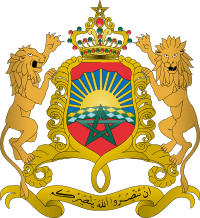Rawd al-Qirtas
Part of a series on the |
|---|
| History of Morocco |
 |
|
Related topics
|
|
|
Rawḍ al-Qirṭās (Arabic: روض القرطاس) is a history of Morocco written in Arabic in the 1326 C.E. It includes many details about the wider Moroccan empire in Iberian Peninsula and Algeria.
The full title of the work is Kitāb al-ānīs al-muṭrib bi-rawḍ al-qirṭās fī ākhbār mulūk al-maghrab wa tārīkh madīnah Fās (The Entertaining Companion Book in the Garden of Pages from the Chronicle of the Kings of Morocco and the History of the City of Fes).[1] The work is usually known by its short title Rawd al-Qirtas meaning The Garden of Pages. It is said that this has a double meaning in that there was a public garden in Fes called The Garden of al-Qirtas, the latter name being a nickname of Ziri ibn Atiyya.[2]
The work has always been very popular in Morocco,[1] and continues so to the present day. In the days before printing, this popularity led to a large number of variant manuscripts. A consequence of this is some uncertainty about the author, who is given in some versions as Ibn Abi Zar of Fes, and by some as Salih ibn Abd al-Halim of Granada. The consensus of modern opinion[3] is that the original author is Ibn Abi Zar as stated by Ibn Khaldun, and that Abd al-Halim is merely a summarizer at best. The double meaning of the title, the detailed history of Fes and numerous mistakes in the geography of Iberia, are cited as evidence that the author was a native of Fes.[2]
The scope of the history is from the advent of Idris I in 788 to the Marinid Dynasty up to 1326. The work falls into four sections, each ending in a summary list of the events in each period:
- The Idrisid and Maghrawa kings
- The Almoravids
- The Almohads
- The Marinids
Modern researchers consider that the first and last sections contain a valuable record of their respective periods, even if not completely free from errors. On the other hand, the sections on the Almoravids and Almohads are considered to be riddled with chronological and factual errors and omissions and make this work one of the least trustworthy sources for those periods.[2] In light of these issues it is unfortunate that Ibn Khaldun chose the work as one of his primary sources of reference.
A critical version of the Arabic text, utilizing all the manuscript versions then available, was published by Tornberg in 1843, and this is generally used as a basis for modern Arabic versions. Tornberg also gave a Latin translation. A French translation was published in 1860 by Beaumier but is based on fewer manuscripts and is considered faulty by modern standards.[2][4] The second (1964) edition of Huici Miranda's Spanish translation is heavily annotated and is considered authoritative.
Notes
- 1 2 Randall, John. "Historia dos Soberanos Mohametanos das primeiras quatro dyastias, e de parte da quinta, que reinarao na Mauritania". Books of Asia. Books of Asia. Retrieved 3 March 2011.
- 1 2 3 4 See introduction by Huici Miranda to the Spanish translation
- ↑ See e.g. notes by Tayeb Habi to the Editions La Porte 1999 edition of Beaumier's translation.
- ↑ e.g. Biyuna is translated as Bayonne but is actually Iruña i.e. Pamplona, as pointed out by Huici Miranda
References
- French translation: A. Beaumier, Rawd al Kirtas. Histoire des Souverains du Maghreb et Annales de la Ville de Fes. Editions La Porte, Rabat, 1999.
- Spanish Translation: A. Huici Miranda, Rawd el-Qirtas. 2nd edition, Anubar Ediciones, Valencia, 1964. Vol. 1 ISBN 84-7013-007-2, vol. 2 ISBN 84-7013-013-7.
- English translation of sections on the Almoravids: N. Levtzion & J.F.P. Hopkins, Corpus of early Arabic sources for West African history, Cambridge University Press, 1981, ISBN 0-521-22422-5 (reprint: Markus Wiener, Princeton, 2000, ISBN 1-55876-241-8).
External links
- Maroc-Hebdo interview (in French) with Tayeb Habi, a recent publisher of Beamier's French translation
- Comparative notes (in English) on sources of Moroccan history during the Almoravid period by French historian Lagadère